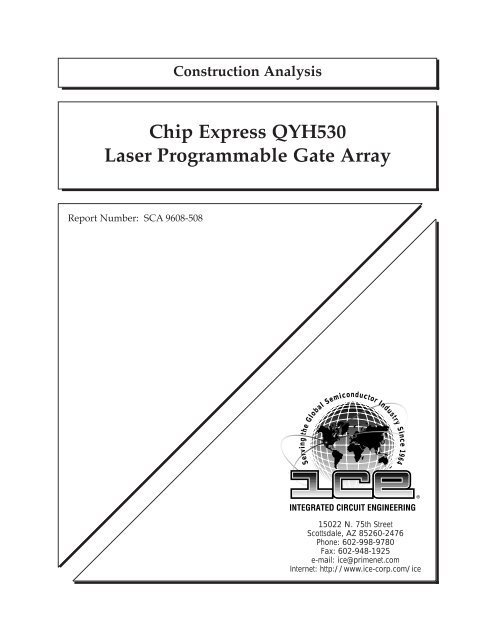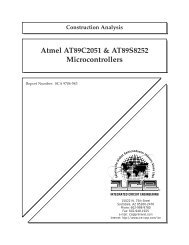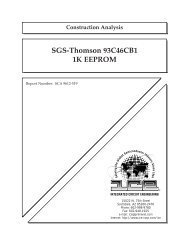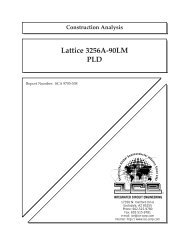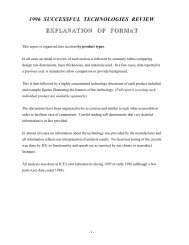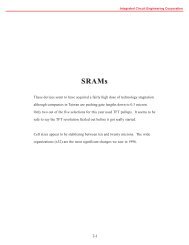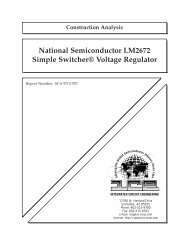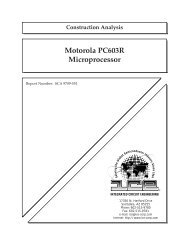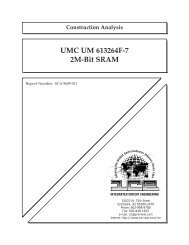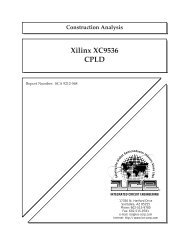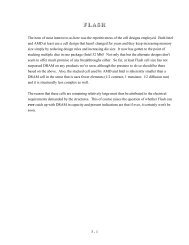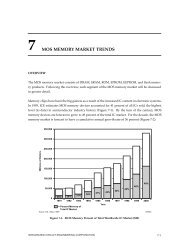ICE Shared Construction Analysis SCA 9608-508 - Smithsonian ...
ICE Shared Construction Analysis SCA 9608-508 - Smithsonian ...
ICE Shared Construction Analysis SCA 9608-508 - Smithsonian ...
Create successful ePaper yourself
Turn your PDF publications into a flip-book with our unique Google optimized e-Paper software.
<strong>Construction</strong> <strong>Analysis</strong><br />
Chip Express QYH530<br />
Laser Programmable Gate Array<br />
Report Number: <strong>SCA</strong> <strong>9608</strong>-<strong>508</strong><br />
Serving the Global Semiconductor Industry Since 1964<br />
15022 N. 75th Street<br />
Scottsdale, AZ 85260-2476<br />
Phone: 602-998-9780<br />
Fax: 602-948-1925<br />
e-mail: ice@primenet.com<br />
Internet: http://www.ice-corp.com/ice<br />
®
TITLE<br />
INDEX TO TEXT<br />
- i -<br />
PAGE<br />
INTRODUCTION 1<br />
MAJOR FINDINGS 1<br />
TECHNOLOGY DESCRIPTION<br />
Die Process and Design 2 - 3<br />
ANALYSIS RESULTS I<br />
Assembly 4 - 5<br />
ANALYSIS RESULTS II<br />
TABLES<br />
Die Process and Design 6 - 9<br />
Procedure 10<br />
Package Markings 11<br />
Wirebond Strength 11<br />
Contact Matrix 12<br />
Die Material <strong>Analysis</strong> 12<br />
Overall Quality Evaluation 13<br />
Horizontal Dimensions 14<br />
Vertical Dimensions 15
INTRODUCTION<br />
This report describes a construction analysis of the Chip Express QYH 530 LPGA (Laser<br />
Personalized Gate Array). Four devices were supplied for the analysis. They were encapsulated<br />
in 160-pin Plastic Quad Flat Packs (PQFP) for surface mount applications. All samples were<br />
date coded 9621.<br />
Questionable Items: 1<br />
MAJOR FINDINGS<br />
• Large silicon nodules occupied up to at least 65 percent 2 of the metal 1 line widths<br />
and 100 percent of the metal thickness. This will increase susceptibility to<br />
electromigration.<br />
• Laser programming of metal 1 blasted holes into the silicon substrate. This was not<br />
passivated particularly well in some cases.<br />
• Many of the polycide gates had “worm holes” beside the sidewall spacers.<br />
Reliability effects are unknown but contaminants may be trapped in these locations.<br />
Special Features:<br />
• These devices are designed to provide very fast turnaround customized IC products, by laser<br />
patterning of photoresist to define metal 2 interconnect and direct laser vaporization of metal<br />
1 “programmable links” (fuses). A highly unusual appearance (but not necessarily<br />
unreliable structure) results.<br />
• Metal 2 was chemically etched (very roughly) for personalization purposes.<br />
• Metal 1 links were laser blown for the same purposes.<br />
1 These items present possible quality or reliability concerns. They should be discussed<br />
with the manufacturer to determine their possible impact on the intended application.<br />
2 Seriousness depends on design margins.<br />
- 1 -
Assembly:<br />
TECHNOLOGY DESCRIPTION<br />
• 160-pin Plastic Quad Flat Pack (PQFP) with gull wing leads for surface mount applications.<br />
• Leadframe and header/paddle constructed of copper (Cu). A dimpled header was employed<br />
for additional package strength.<br />
• Kapton tape was employed to stabilize the leadframe leads.<br />
• Externally leads were plated with tin-lead (SnPb) and internally spot plated with<br />
silver (Ag).<br />
• A silver-epoxy die attach was employed.<br />
• Die did not employ a backside plating.<br />
• A patterned polyimide die coat was employed.<br />
• Thermosonic wirebonding using 1.3 mil O.D. gold wire.<br />
• Wafer dicing was by sawing (full depth).<br />
Die Process and Design<br />
• Fabrication process: Selective oxidation CMOS process employing twin wells in a<br />
P substrate. No epi was used.<br />
• Final passivation: A single layer of silicon-nitride, (under the polyimide die coat).<br />
• Metallization: Two quite different levels of aluminum. Whereas metal 2 used no<br />
cap metal, had apparent normal to light level silicon doping, and a very thin titanium<br />
adhesion layer, metal 1 used both tungsten cap and barrier and appeared significantly<br />
over-doped with silicon.<br />
- 2 -
TECHNOLOGY DESCRIPTION (continued)<br />
• Both metal layers were patterned into standard (pre-customizing) interconnect design<br />
using dry etching. Metal 2 was then apparently patterned into its custom design<br />
using (laser exposed?) photoresist and a dry etch. Metal 1 was customized by laser<br />
vaporization of selected program sites.<br />
• Interlevel dielectric: Two layers of deposited glass; the second of which may have<br />
been a spin-on-glass (SOG) for planarization purposes.<br />
• Pre-metal dielectric: A layer of deposited glass over a layer of BPSG reflow glass<br />
over densified oxide. The reflow glass was reflowed prior to contact cuts only.<br />
• Polysilicon: A single layer of silicided polysilicon (poly and tungsten silicide) was<br />
used to form all gates on the die.<br />
• Diffusions: Standard implanted N+ and P+ diffusions formed the sources/drains of<br />
transistors. Oxide sidewall spacers were used to provide the LDD spacing and were<br />
left in place.<br />
• Wells: Twin wells in a P substrate. No epi was present.<br />
- 3 -
Assembly:<br />
Questionable Items: 1 None.<br />
General Items:<br />
ANALYSIS RESULTS I<br />
- 4 -<br />
Figures 1 - 8<br />
• The devices were encapsulated in a 160-pin Plastic Quad Flat Packs (PQFP) with<br />
gull wing leads for surface mount applications.<br />
• Overall package quality: Good. No defects were found on the external portions of<br />
the package. External pins were well formed and tinning of the leads was complete.<br />
• One package was subjected to a dye penetrant test which revealed that no gaps were<br />
present at lead exits.<br />
• Leadframe: Copper (Cu) leadframe externally tinned with tin-lead (SnPb) solder<br />
and spot plated internally with silver (Ag). A dimpled header/paddle was employed<br />
for additional package strength. No problems were found.<br />
• Kapton tape was employed on the internal leadframe to help stabilize the lead<br />
spacing.<br />
• Die attach: A patterned silver-epoxy die attach was used. Minor voids were noted;<br />
however, they are not severe enough to be a reliability concern.<br />
• Die backside plating was not employed.<br />
• Die dicing: Die separation was by sawing (full depth) with normal quality and<br />
workmanship.<br />
1 These items present possible quality or reliability concerns. They should be discussed<br />
with the manufacturer to determine their possible impact on the intended application.
ANALYSIS RESULTS I (continued)<br />
• Wirebonding: Thermosonic ball bond method using 1.3 mil O.D. gold wire.<br />
Wirebond placement was good. Wire clearance and spacing were normal. Bond<br />
pull strengths were good (see page 11) and no bond lifts occurred. All pins were<br />
connected.<br />
• A thin patterned polyimide die coat was employed.<br />
- 5 -
Die Process and Design:<br />
Questionable Items: 1<br />
ANALYSIS RESULTS II<br />
- 6 -<br />
Figures 9 - 41<br />
• Large silicon nodules occupied up to at least 65 percent 2 of the metal line widths and<br />
100 percent of the metal thickness. This will cause increased susceptibility to metal<br />
migration and possible early failure. It is of particular concern at metal steps into<br />
contacts where metal thins as well.<br />
• Laser programming of metal 1 blasted holes into the silicon substrate. This was not<br />
passivated really well in some cases.<br />
• Many of the polycide gates had “worm holes” beside the sidewall spacers.<br />
Contaminants may be trapped in these.<br />
Special Features:<br />
• These devices are designed to provide very fast turnaround customized IC products, by laser<br />
patterning of photoresist to define metal 2 interconnect and direct laser blowing of metal 1<br />
“programmable links.” A highly unusual appearance (but not necessarily unreliable<br />
structure) results.<br />
• Metal 2 was chemically etched (very roughly) for personalization purposes.<br />
• Metal 1 links were laser blown for the same purposes.<br />
General Items:<br />
• Fabrication process: Selective oxidation CMOS process employing twin-wells in a P<br />
substrate. No epi was present. Basic process implementation appeared to be of good<br />
quality except for metal 1 composition and “worm hole” formation at gate edges.<br />
1 These items present possible quality or reliability concerns. They should be discussed<br />
with the manufacturer to determine their possible impact on the intended application.<br />
2 Seriousness depends on design margins.
ANALYSIS RESULTS II (continued)<br />
• Design implementation: Die layout was clean. Alignment was good at all levels.<br />
• Surface defects: No toolmarks, masking defects, or contamination areas were found.<br />
• Final passivation: A single layer of silicon-nitride was employed. Passivation<br />
integrity tests indicated defect-free passivation. Edge seal was also good.<br />
Passivation quality is especially important since it must also seal the laser<br />
programmed metal 1 links and this process creates holes that penetrate into the<br />
silicon substrate.<br />
• Metallization: Two layers of silicon-doped aluminum. Only metal 1 employed a tungsten<br />
cap and barrier. Metal 2 used a very thin adhesion layer of titanium.<br />
• Metal design: Both metal layers employed slotted bus lines for stress relief.<br />
Apparently a standard interconnect pattern (masterslice type design) using normal<br />
photolithography and dry etch techniques is employed for the basic die design. No<br />
problems were found in this area.<br />
• Custom metal patterning: Both metal layers were selectively patterned for<br />
personalization purposes prior to final passivation. As mentioned, apparently metal 2<br />
is customized by direct laser exposure of photoresist followed by a dry etch.<br />
Although this leaves very rough looking metal edges there was no visible indication of<br />
any problems in this process step nor do we foresee any potential cause for concern.<br />
Metal 1 is also customized, either before or after metal 2 patterning. It is programmed<br />
by direct laser blowing of specific sites where interlevel dielectric and metal 1 cap layer<br />
have been removed. A laser pulse is used to vaporize this metal and in almost all<br />
cases the laser power used is enough to also vaporize the pre-metal dielectric and<br />
substrate silicon (to a depth of 0.3 micron). It is presumed that the apparent excessive<br />
power is required to ensure clearing of the tungsten barrier metal. The holes created<br />
due to this are of some concern because of their location in some places (Figure 28)<br />
and because the nitride passivation does not always appear to seal these areas as well<br />
as might be desirable, leaving visible knit lines (Figure 23).<br />
- 7 -
ANALYSIS RESULTS II (continued)<br />
• Metal defects: No notching or voiding was found but metal 1 silicon nodules<br />
occupied up to 100 percent of the line thickness and up to at least 65 percent of the<br />
line widths (Figure 24). Silicon nodules >50 percent of the line widths can cause an<br />
unacceptable increase in the aluminum's susceptibility to electromigration, but this is<br />
entirely dependent on the die design.<br />
• Metal step coverage: Metal 2 aluminum thinned up to 50 percent at some vias (Figure 16).<br />
Total metal 1 thinning was up to 75 percent, while metal 1 aluminum thinning up to 80<br />
percent occurred at some contacts (Figure 25). The concern that exists is for the combined<br />
effect of the thinning and silicon nodule density. For reference MIL-STD-883D allows up<br />
to 70 percent metal thinning for vias and contacts of this size.<br />
• Contact etch: No overetching of contacts were noted. No problems are foreseen.<br />
• Interlevel dielectric: Two layers of deposited glass; the second of which may have<br />
been a spin-on-glass (SOG) for planarization purposes. No problems were found.<br />
• Pre-metal dielectric: A layer of deposited glass over a layer of BPSG reflow glass<br />
over densified oxide. The reflow glass was reflowed prior to contact cuts only.<br />
Here also no problems were found.<br />
• Polysilicon: The single layer of silicided polysilicon (poly and tungsten silicide) was<br />
used to form all gates on the die. Definition was good and no problems were found<br />
in this area.<br />
• Sidewall spacers: Oxide sidewall spacers were used (and left in place) to provide the<br />
LDD spacing. The reflow glass deposited after S/D implant did not fill the corners<br />
left by the outside edges of the spacers. There is some concern that this was caused<br />
by inadequate cleaning prior to reflow glass deposition, or poor glass/deposition<br />
controls. The effects on product performance or reliability are unknown.<br />
• Isolation: Local oxide (LOCOS). No problems were present at the birdsbeaks or<br />
elsewhere. A step was present in the local oxide at the well boundaries indicating<br />
the presence of a twin-well process.<br />
- 8 -
ANALYSIS RESULTS II (continued)<br />
• Diffusions: Standard implanted N+ and P+ diffusions formed the sources/drains of<br />
MOS transistors. No anomalies were found.<br />
• Wells: Twin-wells were used in a P substrate. The P-wells could not be delineated;<br />
however, the step in the local oxide at the well boundary indicates a twin-well<br />
process. No problems were found.<br />
• Buried contacts: Direct poly-to-diffusion contacts were not employed.<br />
- 9 -
PROCEDURE<br />
The devices were subjected to the following analysis procedures:<br />
External inspection<br />
X-ray<br />
Dye penetrant test<br />
Decapsulation<br />
Internal optical inspection<br />
SEM of assembly features<br />
Wirepull test<br />
Passivation integrity test<br />
Passivation removal and inspect metal 2<br />
Aluminum 2 removal and inspect<br />
Delayer to metal 1 and inspect<br />
Aluminum 1 removal and inspect<br />
Delayer to poly/substrate and inspect<br />
Die sectioning (90° for SEM) *<br />
Measure horizontal dimensions<br />
Measure vertical dimensions<br />
Die material analysis<br />
* Delineation of cross-sections is by silicon etch unless otherwise indicated.<br />
- 10 -
PACKAGE MARKINGS<br />
TOP<br />
CONFIDENTIAL CLIENT ID AND<br />
“M022477-23, 24<br />
9621 USA”<br />
WIREBOND STRENGTH<br />
Wire material: 1.3 mil diameter gold<br />
Die pad material: aluminum<br />
Material at package post: silver<br />
Sample #<br />
# of wires tested: 40<br />
Bond lifts: 0<br />
Force to break - high: 12.0g<br />
- low: 7.0g<br />
- avg.: 9.8g<br />
- std. dev.: 1.5<br />
- 11 -
Metal 2<br />
CONTACT MATRIX<br />
Metal 1<br />
Metal 2: X<br />
- 12 -<br />
Polycide<br />
Metal 1: X X X X<br />
Polycide: X<br />
Note: X = direct connection.<br />
DIE MATERIALS<br />
Passivation: Silicon-nitride.<br />
Metal 2 - aluminum: Aluminum doped with silicon (no copper was detected). *<br />
- adhesion layer: Titanium.<br />
Metal 1 - cap: Tungsten.<br />
- aluminum: Aluminum doped with silicon (no copper was detected). *<br />
- barrier: Tungsten.<br />
Reflow glass: Borophosphosilicate glass (BPSG) containing 3.0 wt. percent<br />
boron and 5.0 wt. percent phosphorus.<br />
Polycide: Tungsten (W) silicide.<br />
* There is no known method for determining the exact amount of silicon or copper in the<br />
aluminum on a finished die.<br />
N+<br />
P+
OVERALL QUALITY EVALUATION: Overall Rating: Normal to Poor<br />
DETAIL OF EVALUATION<br />
Package integrity G<br />
Package markings G<br />
Lead conformity G<br />
Lead plating quality G<br />
Die placement G<br />
Die attach quality N<br />
Wire spacing N<br />
Wirebond placement G<br />
Wirebond quality G<br />
Dicing quality N<br />
Wirebond method Thermosonic ball bonds using 1.3 mil gold wire<br />
Die attach method Silver-filled epoxy<br />
Dicing method Sawn (full depth)<br />
Die surface integrity:<br />
Tool marks (absence) G<br />
Particles (absence) G<br />
Contamination (absence) N<br />
Process defects (absence) N<br />
General workmanship N<br />
Passivation integrity N<br />
Metal definition N<br />
Metal integrity NP *<br />
Metal registration G<br />
Contact coverage G<br />
Contact registration G<br />
* Large silicon nodules and thinning at steps (M1).<br />
G = Good, P = Poor, N = Normal, NP = Normal/Poor<br />
- 13 -
HORIZONTAL DIMENSIONS<br />
Die size: 9.5 x 9.5 mm (375 x 375 mils)<br />
Die area: 91 mm 2 (140,625 mils 2 )<br />
Min pad size: 0.10 x 0.12 mm (4.3 x 4.8 mils)<br />
Min pad window: 0.10 x 0.10 mm (3.9 x 3.9 mils)<br />
Min pad spacing: 5 microns<br />
Min pad-to-metal: 10 microns<br />
Min metal 2 width: 1.6 micron<br />
Min metal 2 space: 0.9 micron<br />
Metal 2 pitch: 3.3 microns<br />
Min via: 1.3 micron (round)<br />
Metal 2 etch pattern: 2.35 x 3.9 microns (oval)<br />
Min metal 1 width: 0.9 micron<br />
Min metal 1 space: 1.0 micron<br />
Metal 1 pitch: 2.4 microns<br />
Min contact: 1.0 micron (round)<br />
Min contact-to-gate: 0.9 micron<br />
Metal 1 cap removed at fuse: 1.5 micron<br />
Metal 1 fuse window: 1.5 x 2.35 microns (oval)<br />
Min polycide width: 0.75 micron<br />
Min polycide space: 2.1 microns<br />
Min gate length * - (N-channel): 0.8 micron<br />
* Physical gate length.<br />
- (P-channel): 0.75 micron<br />
- 14 -
VERTICAL DIMENSIONS<br />
Die thickness: 0.6 mm (24 mils)<br />
Layers<br />
Die coat: 2.5 microns<br />
Passivation: 0.8 micron<br />
Metal 2: 1.0 micron<br />
Metal 2 overetch depth: 0.2 micron<br />
Interlevel glass: 0.7 micron (average)<br />
Metal 1 - cap: 0.08 micron (approx.)<br />
- aluminum: 0.4 micron<br />
- barrier: 0.08 micron (approx.)<br />
Holes created by M1 programming: 0.9 micron<br />
Vaporized (by laser zap) substrate: 0.3 micron<br />
Pre-metal glass: 0.6 micron (average)<br />
Polycide - silicide: 0.2 micron<br />
- poly: 0.15 micron<br />
Local oxide: 0.4 micron<br />
N+ S/D diffusion: 0.15 micron<br />
P+ S/D diffusion: 0.15 micron<br />
N- well: 4.5 microns<br />
P- well: Could not delineate<br />
- 15 -
INDEX TO FIGURES<br />
PACKAGE ASSEMBLY Figures 1 - 8<br />
DIE LAYOUT AND IDENTIFICATION Figures 9 - 10a<br />
PHYSICAL DIE STRUCTURES Figures 9 - 40<br />
PROGRAMMABLE ARRAY Figures 32 - 39<br />
I/O LAYOUT AND METAL LAYOUT Figure 40<br />
COLOR PROCESS DRAWING Figure 41<br />
- ii -
Otis Elevator AAA616QG1<br />
Integrated Circuit Engineering Corporation<br />
Figure 1. Package photograph and x-ray of the Otis Elevator AAA616QG1. Mag. 2x.
LEADFRAME<br />
KAPTON TAPE<br />
Figure 2. Portion of the package section illustrating general construction. Mag. 20x.<br />
Cu HEADER<br />
DIE<br />
Otis Elevator AAA616QG1<br />
Integrated Circuit Engineering Corporation
Otis Elevator AAA616QG1<br />
Cu LEAD<br />
PLASTIC PACKAGE<br />
Cu LEAD<br />
Cu LEAD<br />
SnPb PLATING<br />
Figure 3. Package section views illustrating lead exit.<br />
Integrated Circuit Engineering Corporation<br />
PLASTIC<br />
PACKAGE<br />
Mag. 30x<br />
Mag. 180x<br />
Mag. 360x
Otis Elevator AAA616QG1<br />
PLASTIC PACKAGE<br />
Mag. 65x<br />
Mag. 130x<br />
KAPTON TAPE<br />
Cu LEAD<br />
KAPTON TAPE<br />
Cu LEAD<br />
PLASTIC PACKAGE<br />
Figure 3a. Optical package section views illustrating Kapton tape.<br />
Integrated Circuit Engineering Corporation
Otis Elevator AAA616QG1<br />
DIE ATTACH<br />
Cu HEADER<br />
PLASTIC PACKAGE<br />
Cu HEADER<br />
Cu HEADER<br />
Integrated Circuit Engineering Corporation<br />
Mag. 50x<br />
Mag. 80x<br />
Mag. 400x<br />
Figure 4. Optical package section views illustrating dicing and die attach.<br />
DIE<br />
DIE<br />
Ag PLATING<br />
DIE
Otis Elevator AAA616QG1<br />
DIE ATTACH ETCHED<br />
DURING DECAPSULATION<br />
Mag. 930x<br />
Mag. 1000x<br />
Figure 5. SEM views illustrating die corner and edge seal.<br />
Integrated Circuit Engineering Corporation
Otis Elevator AAA616QG1<br />
Mag. 1600x<br />
PASSIVATION<br />
METAL 2<br />
SUBSTRATE<br />
Mag. 6500x<br />
EDGE SEAL<br />
SUBSTRATE<br />
Figure 6. SEM section views illustrating edge seal.<br />
Integrated Circuit Engineering Corporation<br />
METAL 1
Otis Elevator AAA616QG1<br />
DIE COAT<br />
Au<br />
INTERMETALLIC<br />
DIE<br />
Figure 7. Optical section view illustrating a typical ball bond. Mag. 800x<br />
LEADFRAME<br />
Figure 8. SEM views illustrating typical wirebonds.<br />
Integrated Circuit Engineering Corporation<br />
Mag. 1000x<br />
Mag. 800x
Otis Elevator AAA616QG1<br />
Figure 9. The Otis Elevator AAA616QG1 intact circuit die. Mag. 16x.<br />
Integrated Circuit Engineering Corporation
Otis Elevator AAA616QG1<br />
Mag. 160x<br />
Mag. 130x<br />
Figure 10. Optical views of die markings.<br />
Integrated Circuit Engineering Corporation
Otis Elevator AAA616QG1<br />
Figure 10a. Optical views of die markings. Mag. 160x.<br />
Integrated Circuit Engineering Corporation
Otis Elevator AAA616QG1<br />
METAL 1<br />
LOCAL OXIDE<br />
METAL 1<br />
ILD<br />
METAL 2<br />
POLYCIDE GATE<br />
N+ S/D<br />
PASSIVATION<br />
METAL 2<br />
Integrated Circuit Engineering Corporation<br />
Mag. 6500x<br />
silicon etch,<br />
Mag. 13,000x<br />
glass etch,<br />
Mag. 13,000x<br />
Figure 11. SEM section views illustrating general structure. Mag. 13,000x.<br />
Si<br />
METAL 1<br />
POLYCIDE<br />
PASSIVATION<br />
METAL 2<br />
ILD<br />
POLYCIDE
Otis Elevator AAA616QG1<br />
Mag. 3000x<br />
Mag. 6000x<br />
Figure 12. SEM views illustrating passivation coverage. 60°.<br />
Integrated Circuit Engineering Corporation<br />
METAL 2 ETCHED<br />
(CUSTOMIZED)
Otis Elevator AAA616QG1<br />
METAL 1<br />
ILD<br />
PASSIVATION<br />
METAL 1<br />
PRE-METAL GLASS<br />
Mag. 13,000x<br />
PASSIVATION<br />
METAL 2<br />
ILD<br />
Mag. 26,000x<br />
Figure 13. SEM section views illustrating metal 2 line profiles. Glass etch.<br />
Integrated Circuit Engineering Corporation<br />
METAL 2<br />
Ti ADHESION LAYER
Otis Elevator AAA616QG1<br />
METAL 2<br />
METAL 1<br />
PROGRAM SITE<br />
METAL 2<br />
METAL 2<br />
ETCHED<br />
(CUSTOMIZED)<br />
ETCHED<br />
Figure 14. Topological SEM views illustrating metal 2 patterning. 0°.<br />
Integrated Circuit Engineering Corporation<br />
Mag. 1600x<br />
Mag. 3250x<br />
Mag. 6500x
Otis Elevator AAA616QG1<br />
ETCHED<br />
METAL 2<br />
ETCHED<br />
METAL 2<br />
METAL 2<br />
Figure 15. SEM views of metal 2 step coverage. 60°.<br />
Integrated Circuit Engineering Corporation<br />
Mag. 3000x<br />
Mag. 6000x<br />
Mag. 12,000x
Otis Elevator AAA616QG1<br />
ETCHED<br />
METAL 2<br />
METAL 2<br />
ETCHED<br />
METAL 2<br />
ETCHED<br />
Figure 15a. SEM views illustrating metal 2 patterning in periphery.<br />
Integrated Circuit Engineering Corporation<br />
Mag. 1600x, 0°<br />
Mag. 3000x, 60°<br />
Mag. 6000x, 60°
Otis Elevator AAA616QG1<br />
PASSIVATION METAL 2<br />
METAL 1<br />
ILD<br />
PRE-METAL GLASS<br />
PASSIVATION<br />
METAL 1<br />
METAL 2<br />
Figure 16. SEM views illustrating metal 2-to-metal 1 vias.<br />
Integrated Circuit Engineering Corporation<br />
ILD<br />
aluminum removed,<br />
Mag. 30,000x, 45°<br />
glass etch,<br />
Mag. 13,000x<br />
glass etch,<br />
Mag. 26,000x
Otis Elevator AAA616QG1<br />
Mag. 26,000x<br />
Mag. 52,000x<br />
Figure 17. SEM section views illustrating metal 1 line profile. Glass etch.<br />
POLYCIDE<br />
ILD<br />
ALUMINUM 1<br />
Si<br />
PRE-METAL GLASS<br />
ILD<br />
METAL 1<br />
RESIDUAL ILD<br />
Si<br />
W BARRIER<br />
W CAP<br />
W CAP<br />
ALUMINUM 1<br />
W BARRIER<br />
RESIDUAL<br />
METAL 2<br />
Figure 18. Topological SEM view of metal 1 patterning. Mag. 5000x, 0°.<br />
Integrated Circuit Engineering Corporation
Otis Elevator AAA616QG1<br />
RESIDUAL METAL 2<br />
METAL 1<br />
METAL 1<br />
POLYCIDE<br />
RESIDUAL METAL 2<br />
W CAP<br />
FUSE LINK<br />
ALUMINUM 1<br />
W BARRIER<br />
Figure 19. SEM views illustrating metal 1 step coverage. 60°.<br />
Integrated Circuit Engineering Corporation<br />
Mag. 6500x<br />
Mag. 13,000x<br />
Mag. 13,000x
Otis Elevator AAA616QG1<br />
METAL 1<br />
METAL 1<br />
intact<br />
blown<br />
POLYCIDE<br />
ALUMINUM 1<br />
POLYCIDE<br />
EXAGGERATED DURING DELAYERING<br />
W BARRIER<br />
Integrated Circuit Engineering Corporation<br />
Figure 20. Topological SEM views of metal 1 fuse links. Mag. 10,000x, 0°.
Otis Elevator AAA616QG1<br />
METAL 1<br />
METAL 1<br />
Mag. 6500x<br />
POLYCIDE<br />
ALUMINUM 1<br />
W BARRIER<br />
Mag. 26,000x<br />
Figure 21. SEM views illustrating metal 1 fuse links. 60°.<br />
Integrated Circuit Engineering Corporation<br />
RESIDUAL METAL 2
Otis Elevator AAA616QG1<br />
POLYCIDE<br />
W BARRIER<br />
METAL 1<br />
ALUMINUM 1<br />
PRE-METAL GLASS<br />
Mag. 13,000x<br />
PRE-METAL<br />
GLASS<br />
“WORMHOLE”<br />
SUBSTRATE<br />
Mag. 26,000x<br />
PASSIVATION<br />
Figure 22. SEM section views of an intact metal 1 fuse link. Glass etch.<br />
ILD<br />
SUBSTRATE<br />
Integrated Circuit Engineering Corporation<br />
PASSIVATION<br />
POLYCIDE
Otis Elevator AAA616QG1<br />
“WORMHOLE”<br />
KNIT LINE<br />
SUBSTRATE<br />
SUBSTRATE<br />
PASSIVATION<br />
PRE-METAL<br />
GLASS<br />
SUBSTRATE<br />
PASSIVATION<br />
POLISHING ARTIFACT<br />
PASSIVATION<br />
Figure 23. SEM section views of a blown metal 1 link. Glass etch.<br />
ILD<br />
POLYCIDE<br />
POLYCIDE<br />
Integrated Circuit Engineering Corporation<br />
ILD<br />
Mag. 13,000x<br />
Mag. 26,000x<br />
Mag. 52,000x
Otis Elevator AAA616QG1<br />
BARRIER<br />
BARRIER<br />
Si<br />
BARRIER<br />
Si<br />
Integrated Circuit Engineering Corporation<br />
Mag. 8000x<br />
Mag. 15,000x<br />
Mag. 19,000x<br />
Figure 24. Topological SEM views illustrating metal 1 silicon nodules. 0°.<br />
Si
Otis Elevator AAA616QG1<br />
N+ DIFFUSION<br />
Si<br />
DIFFUSION<br />
Si<br />
DIFFUSION<br />
Si<br />
ALUMINUM 1<br />
METAL 1<br />
ALUMINUM 1<br />
METAL 2<br />
POLYCIDE<br />
Integrated Circuit Engineering Corporation<br />
Mag. 13,000x<br />
Mag. 26,000x<br />
Mag. 26,000x<br />
Figure 24a. Section views illustrating silicon nodules at contacts. Silicon etch.<br />
Si
Otis Elevator AAA616QG1<br />
BARRIER<br />
Si<br />
Mag. 20,000x, 45°<br />
glass etch, Mag. 26,000x<br />
Figure 25. SEM views illustrating typical contact cuts.<br />
ILD<br />
THINNING<br />
METAL 1<br />
POLYCIDE<br />
POLYCIDE<br />
Integrated Circuit Engineering Corporation<br />
PASSIVATION<br />
INTERMEDIATE<br />
GLASS
Otis Elevator AAA616QG1<br />
POLYCIDE<br />
METAL 1<br />
ILD<br />
SUBSTRATE<br />
glass etch<br />
METAL 1<br />
PASSIVATION<br />
Figure 26. SEM section views illustrating typical contacts. Mag. 26,000x.<br />
Si<br />
N+ S/D<br />
Integrated Circuit Engineering Corporation<br />
PREMETAL<br />
GLASS<br />
ILD<br />
POLYCIDE
Otis Elevator AAA616QG1<br />
N+ DIFFUSION<br />
POLYCIDE<br />
POLYCIDE<br />
Mag. 1500x<br />
Mag. 3000x<br />
Figure 27. Topological SEM views of polycide patterning. 0°.<br />
Integrated Circuit Engineering Corporation<br />
N+<br />
DIFFUSION
Otis Elevator AAA616QG1<br />
P+ DIFFUSION<br />
METAL 1 PROGRAMMING<br />
HOLE (EXAGGERATED BY<br />
DELAYERING)<br />
POLYCIDE<br />
Mag. 1600x<br />
N+ DIFFUSION<br />
Mag. 3250x<br />
N+ DIFFUSION<br />
Figure 28. SEM views of polycide step coverage. 60°.<br />
Integrated Circuit Engineering Corporation
Otis Elevator AAA616QG1<br />
POLYCIDE<br />
N+ DIFFUSION<br />
Mag. 13,000x<br />
POLYCIDE<br />
Mag. 26,000x<br />
Figure 29. Detailed SEM views of polycide step coverage. 60°.<br />
Integrated Circuit Engineering Corporation<br />
N+ DIFFUSION
Otis Elevator AAA616QG1<br />
POLYCIDE GATE<br />
PRE-METAL GLASS<br />
POLYCIDE GATE<br />
POLYCIDE GATE<br />
GATE OXIDE<br />
METAL 1<br />
Figure 30. SEM section views of typical gates. Mag. 52,000x.<br />
Integrated Circuit Engineering Corporation<br />
SIDEWALL SPACER<br />
P+ S/D<br />
SIDEWALL SPACER<br />
N+ S/D<br />
SIDEWALL SPACER<br />
P-channel<br />
N-channel<br />
glass etch
Otis Elevator AAA616QG1<br />
P+ DIFFUSION<br />
LOCAL OXIDE<br />
SUBSTRATE<br />
N-WELL<br />
PRE-METALGLASS<br />
LOCAL OXIDE<br />
PRE-METAL GLASS<br />
POLYCIDE<br />
Integrated Circuit Engineering Corporation<br />
N+ DIFFUSION<br />
GATE OXIDE<br />
Mag. 800x<br />
Mag. 26,000x<br />
Mag. 52,000x<br />
Figure 31. SEM section views illustrating well structure, step at well boundary, and a<br />
birdsbeak.
Otis Elevator AAA616QG1<br />
Figure 32. Optical view of programmable array. Mag. 640x.<br />
Integrated Circuit Engineering Corporation
Otis Elevator AAA616QG1<br />
INTERMEDIATE GLASS<br />
PASSIVATION<br />
METAL 2<br />
ETCHED<br />
PASSIVATION<br />
ILD<br />
PASSIVATION<br />
METAL 2<br />
METAL 2<br />
INTACT<br />
Integrated Circuit Engineering Corporation<br />
Mag. 13,000x<br />
Mag. 26,000x<br />
Mag. 26,000x<br />
Figure 33. SEM section views illustrating (custom) mask etching of metal 2. Glass etch.<br />
ILD<br />
ILD
Otis Elevator AAA616QG1<br />
Mag. 6000x<br />
Mag. 12,000x<br />
Figure 33a. SEM views of passivation coverage. 60°.<br />
Integrated Circuit Engineering Corporation<br />
METAL 2 ETCHED<br />
METAL 1 INTACT<br />
METAL 1 BLOWN
Otis Elevator AAA616QG1<br />
METAL 2 ETCHED<br />
METAL 2 ETCHED<br />
INTACT METAL 1 BLOWN METAL 1<br />
intact<br />
INTACT METAL 1<br />
passivation removed<br />
Figure 34. Topological SEM views of programmable array. Mag. 3250x.<br />
Integrated Circuit Engineering Corporation<br />
BLOWN METAL 1
Otis Elevator AAA616QG1<br />
METAL 2<br />
ETCHED<br />
METAL 1<br />
ETCHED<br />
METAL 2<br />
BLOWN<br />
ETCHED<br />
METAL 2<br />
Figure 35. SEM views illustrating programmable array topology. 60°.<br />
Integrated Circuit Engineering Corporation<br />
Mag. 6000x<br />
Mag. 12,000x<br />
Mag. 12,000x
Otis Elevator AAA616QG1<br />
RESIDUAL<br />
METAL 2<br />
DAMAGED<br />
BLOWN<br />
INTACT<br />
BLOWN<br />
Mag. 5000x<br />
INTACT<br />
Mag. 10,000x<br />
METAL 1<br />
Figure 36. Topological views of metal 1 in programmable array. 0°.<br />
Integrated Circuit Engineering Corporation<br />
EXAGGERATED DURING<br />
DELAYERING<br />
RESIDUAL METAL 2 EXAGGERATED DURING<br />
DELAYERING<br />
METAL 1
Otis Elevator AAA616QG1<br />
CAP<br />
METAL 1<br />
Mag. 13,000x<br />
ALUMINUM<br />
Mag. 26,000x<br />
BARRIER<br />
Integrated Circuit Engineering Corporation<br />
Figure 37. SEM views illustrating intact metal 1 programmable fuse links in<br />
programmable array. 60°.
Otis Elevator AAA616QG1<br />
Mag. 13,000x<br />
Mag. 26,000x<br />
Integrated Circuit Engineering Corporation<br />
PASSIVATION<br />
METAL 2<br />
Figure 38. SEM section views illustrating intact metal 1 fuse link in programmable<br />
array. Glass etch.<br />
ILD<br />
Si METAL 1<br />
PRE-METAL GLASS<br />
SUBSTRATE<br />
PRE-METAL GLASS<br />
PASSIVATION<br />
METAL 1<br />
ILD<br />
METAL 2
Otis Elevator AAA616QG1<br />
PRE-METAL GLASS<br />
Mag. 13,000x<br />
PASSIVATION<br />
POLISHING ARTIFACT<br />
Mag. 26,000x<br />
Integrated Circuit Engineering Corporation<br />
PASSIVATION<br />
METAL 2<br />
METAL 1<br />
Figure 39. SEM section views illustrating a blown fuse link in the programmable array.<br />
Glass etch.<br />
ILD<br />
PRE-METAL GLASS<br />
CAP<br />
ILD<br />
METAL 2<br />
ALUMINUM 1<br />
BARRIER
Otis Elevator AAA616QG1<br />
Mag. 160x<br />
Mag. 320x<br />
Integrated Circuit Engineering Corporation<br />
Figure 40. Optical views illustrating typical I/O structure and bus metal layout.
PASSIVATION<br />
INTERLEVEL DIELECTRIC 2<br />
N+ S/D<br />
POLYCIDE GATE<br />
P-WELL<br />
,,,,,,,,<br />
P SUBSTRATE<br />
Ti ADHESION LAYER<br />
METAL 2<br />
METAL 1<br />
PRE-METAL DIELECTRIC<br />
LOCAL OXIDE<br />
N-WELL<br />
P+ S/D<br />
Orange = Nitride, Blue = Metal, Yellow = Oxide, Green = Poly,<br />
Red = Diffusion, and Gray = Substrate<br />
Figure 41. Color cross section drawing illustrating device structure.<br />
INTERLEVEL DIELECTRIC 1<br />
GATE OXIDE<br />
SIDEWALL SPACER<br />
Otis Elevator AAA616QG1<br />
Integrated Circuit Engineering Corporation


